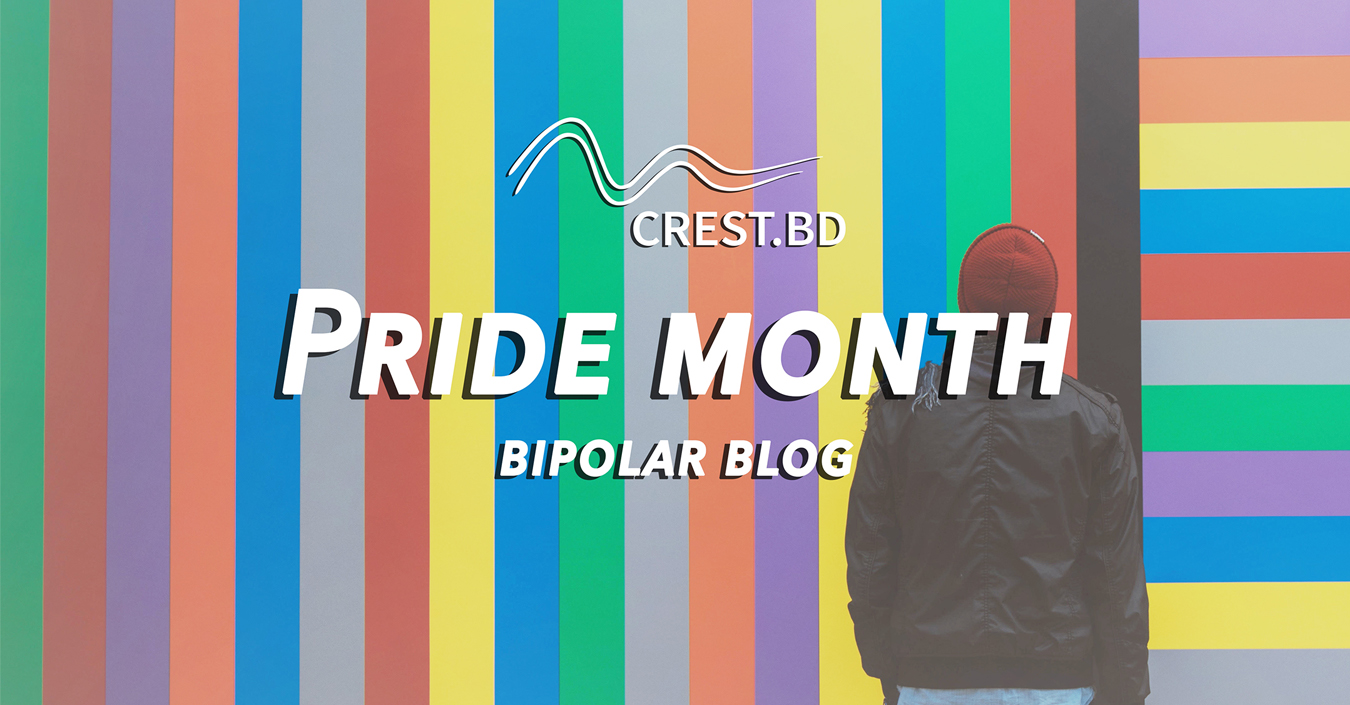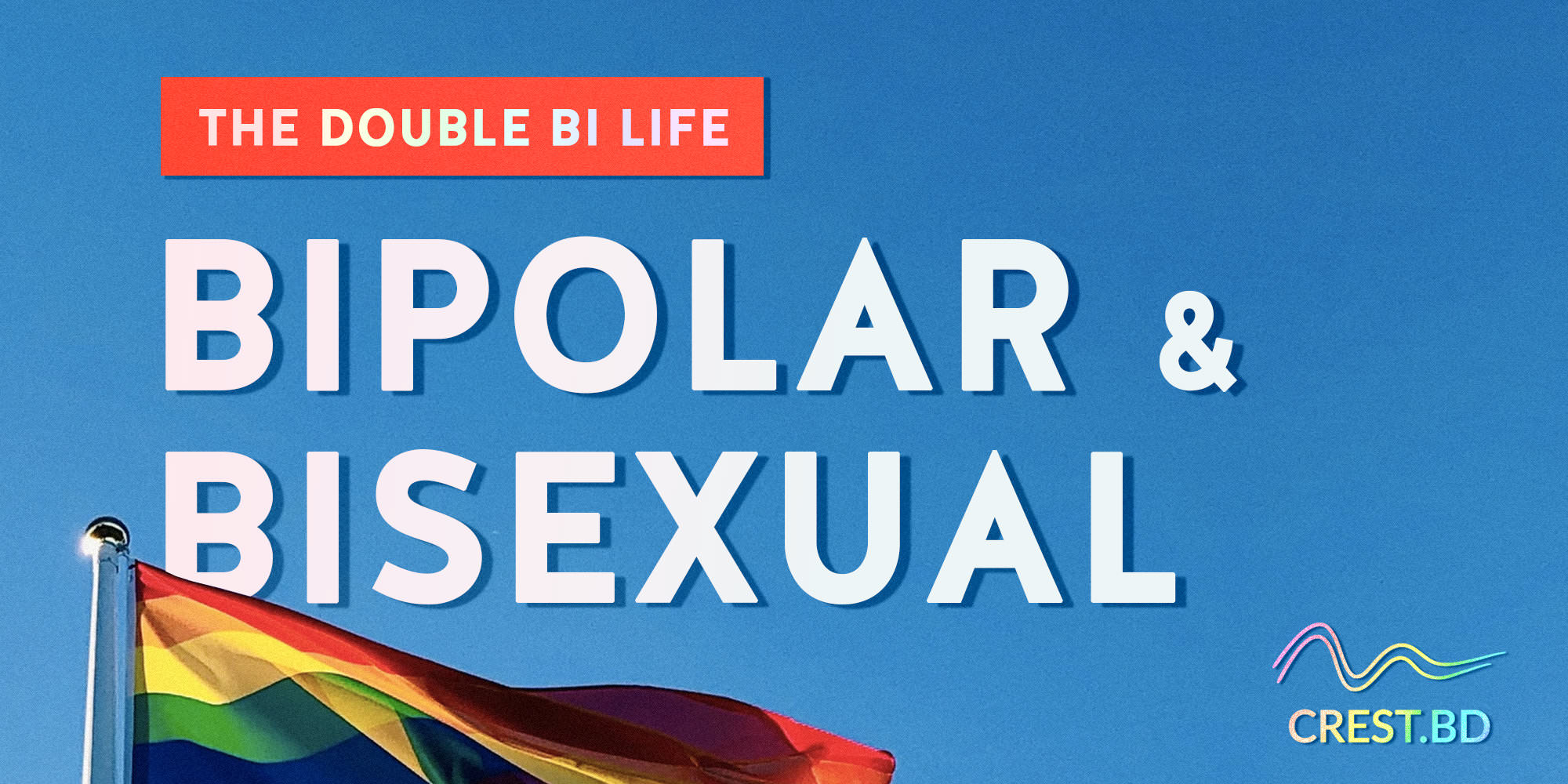“So are you straight like a ruler or curved like a protractor?” my best friend asked me on our first day at university to inquire if I identified as straight, gay, or something in-between. Living as an openly bisexual person in today’s socio-political climate can be difficult enough; adding one of the most highly stigmatized mental health diagnoses on top of that is a whole other challenge. With every new university course and professor, every new workplace, boss, and co-worker, with every new person I meet or interaction I have, there is an appraisal of safety and decision to be made about whether disclosing either my queer identity or diagnosis of bipolar II disorder is worth the potential fallout. How is it that something as simple as living openly and unabashedly as myself so greatly affects my every day?
In case you’re unfamiliar with either bisexuality or bipolar disorder (BD), I’ll provide a brief introduction to each from the perspective of someone with lived experience for both. Contrary to popular belief, bisexuality isn’t simply being attracted to both men and women. A better definition is that bisexuality is having “physical, emotional, sexual, and romantic attraction to people of more than one gender” (Bisexual Resource Center, 2018), that is, bisexuality is inclusive of an entire spectrum of gender identities. Being bisexual can mean being attracted to men, women, and nonbinary-identifying individuals, or any combination thereof: one person’s bisexuality does not have to look like another’s, which can also be said of bipolar disorder. In contrast to the depressive and manic episodes of bipolar I disorder, bipolar II is characterized by depressive and hypomanic episodes, shorter periods of elevated mood that are often considered to cause less impairment to daily functioning than manic episodes and have no psychotic features (e.g., hallucinations or delusions). In 2007, the estimated lifetime prevalence of BD I and II was between 1 and 2%, meaning approximately 500,000 Canadians live with the condition (Merikangas et al.).
While in recent years new research has strived to be more inclusive of the lesbian, gay, bisexual, transgender, queer, and two-spirit (LGBTQ2S) community and promote the need more informed care, more work still needs to be done. New studies still often fail to be inclusive of sexual and gender minority identities, and even research focused specifically on the LGBTQ2S community sometimes fails to adequately differentiate between biological sex and gender identity so as to be inclusive of transgender and/or nonbinary-identifying individuals. At the time of writing this blog, a search of PsycINFO, an online database of articles, abstracts, and citations of behavioural and social science research that boasts an impressive 4.5 million records, for the terms “transgender” or “nonbinary” in combination with “bipolar disorder” wields only 6,581 results. The majority of the resulting articles appear to either focus on LGB identities rather than gender or have little to no specific mention of bipolar disorder. The same search produces a mere 7 results in a more biomedically-focused research database, PubMed, further emphasizing the lack of inclusive research. This is important because people in the community can face specific barriers associated with their sexual and/or gender identities that, when combined with other minority identities (e.g., race or mental health condition), can create greater feelings of alienation due to the lack of intersectional inclusion and understanding in the general population, even in “safe spaces” designed to protect and provide aid for LGBTQ2S individuals (Pilling et al., 2017). Though we have come a long way in terms of inclusivity in research, there is still more to be done both in the academic community and in providing care and resources that are tailored for people who live with multiple stigmatized identities.
I’ve been living as an out-and-proud bisexual woman since the age of 13 and openly with the diagnosis of bipolar II since age 17. In my experience, being open about both my sexuality and diagnosis can lead to a slew of invasive and demoralizing questions, ranging from “so does that mean you’ll have a threesome with me and another girl?” from boys in my grade eight classes, to “so does that mean sometimes you’re sad and sometimes you’re crazy?” from ex-partners. It’s entirely up to me to decide whether to share the answers to these or any other questions about my identities with those who ask: the public has no place in my brain, my body, or my bedroom. Balancing bisexuality and bipolar II means to balance living with twice the stigma, and therefore twice of the fear of social rejection, isolation, and discrimination should I choose to live loudly and embrace both of these identities. If I could be considered a representation of intersectionality, my partner does so on another level: a bisexual, nonbinary (they/them/theirs pronouns), and neurodivergent person of colour, they never cease to amaze and inspire me by living and loving openly and unapologetically. These identities exist, embodied in real people with lived experience – we are more than these or any other labels, and we deserve better representation and care designed specifically to speak to our experiences and needs. I’m tremendously proud to be a queer and neurodivergent person working in mental health research as a student and in my role with CREST.BD (www.crestbd.ca). I look forward to collaborating with both academic and clinical communities to advance and expand our research and care in pursuit support of full inclusion and better care for all.
About Hannah Rosen
Hannah Rosen is a third year psychology student at the University of British Columbia and a peer-researcher with the Collaborative RESearch team to study psychosocial issues in Bipolar Disorder (CREST.BD). It’s been a pleasure for her to produce this blog for both the International Society for Bipolar Disorders (ISBD) and CREST.BD communities during Pride Month 2018.
References
Bisexual Resource Center. (2018). Bi youth. Retrieved from biresource.org/resources/youth
Merikangas, K. R., Akiskal, H. S., Angst, J., Greenberg, P. E., Hirschfeld, R. M. A., Petukhova, M., & Kessler, R. C. (2007). Lifetime and 12-month prevalence of bipolar spectrum disorder in the national comorbidity survey replication. Archives of General Psychiatry, 64(5), 543–552. doi.org/10.1001/archpsyc.64.5.543
Pilling, M., Howison, M., Frederick, T., Ross, L., Bellamy, C. D., Davidson, L., McKenzie, K., & Kidd, S. (2017). Fragmented inclusion: Community participation and lesbian, gay, bisexual, trans, and queer people with diagnoses of schizophrenia and bipolar disorder. Am J Orthopsychiatry, 87(5), 606–613. doi:10.1037/ort0000215
Resources
The CREST.BD Bipolar Wellness Centre, www.bdwellness.com
Parents and Friends of Lesbians and Gays (PFLAG), www.pflag.org: A U.S.-based international support network for allies and LGBTQ2S community members.
LGBT National Help Center, www.glbthotline.org: A network of hotlines, online peer-support chats, and online support groups for LGBTQ2S community members of any age or identity.
More About Bipolar Disorder & Bisexuality
“Sometimes I’ll joke that I just can’t decide between being straight or gay, hypomanic or depressed.”






this made me feel so much less alone.
dont feel alone, i will be there for you!!
I feel you bud.
Thank you for writing. It felt good. I have to shoutout the so betitled psychadelic 2cb as well! Ayahuasca helped first, then a few 2cb sessions with diverse group of truly good (and bad) friends got me over the line to accept the identity. Greetings from Amsterdam, the Netherlands.
I have been undiagnosed for 54 years and only this year I finally figured out my life. I love the term used In this above because it fits me perfectly. Bibi’s meaning bisexual and bipolar. I am getting all the help I needed now. My wife and family are all behind me and love me to the fullest.